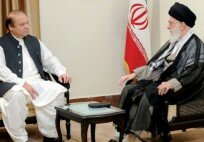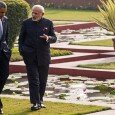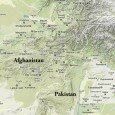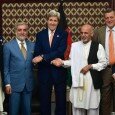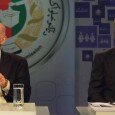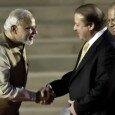By Rahimullah Yusufzai –
Pak-India ties
As common Indians and Pakistanis increasingly show goodwill to each other and oppose yet another war between the two neighbouring countries, their governments continue to endlessly discuss old and new issues without achieving any real breakthrough in the talks. However, both New Delhi and Islamabad, in a welcome departure from the past, are no longer insisting that the Mumbai 2008 attacks and the Kashmir dispute needed to be resolved first before any progress could be made on the other problems plaguing their relations.
During a recent visit to India, one could feel a sense of anticipation with regard to the coming rounds of Indo-Pakistan talks on a host of issues, even though most Indians weren’t expecting any quick solution of the many disputes that are being discussed. Still, it was reassuring for all concerned that officials of the two arch-rival nations were willing to sit and talk after the breakdown of their composite dialogue following the carnage in Mumbai in November, 2008.
In interaction with serving and retired Indian officials, opinion-makers and experts from different fields, one got the message that India won’t make any territorial concessions to Pakistan on any issue, be it Kashmir, Siachen or Sir Creek. There was a clear hardening of the Indian position on these and other issues, a fact testified by Pakistani officials who have been holding talks with their counterparts from India in recent months. Though the Indians maintain that they are merely reiterating their past position on these issues, the Pakistanis promptly pinpoint the difference in the past and recent Indian stance on the Siachen Glacier and Sir Creek to reinforce their view that New Delhi was taking a harder position and making it difficult to achieve any breakthrough in the talks.
The reasons for the tougher Indian position on the disputed issues are obvious. India’s growing international stature is one such reason and its impressive economic growth in recent years is another. Another important cause of Indian sense of superiority is Pakistan’s steady decline due to its mounting security, political and economic problems. There seems to be a feeling in India that a weakened Pakistan won’t be able to sustain its past position on bilateral issues between the two countries. In fact, some Indian analysts believe that Pakistan’s willingness to improve trade relations with India and finally grant it the status of the most favoured nation (MFN) was on account of its difficult economic situation.
The recent thaw in the relationship between India and Pakistan became possible when both countries retreated somewhat from their previously held positions. India gave up its demand that no meaningful talks with Pakistan on other issues were possible until it first brought to justice the alleged perpetrators of the Mumbai attacks. In particular, it wanted Pakistan to apprehend the Jamaat-ud-Dawa head Hafiz Mohammad Saeed, who was acquitted by a court and is now a free man, and make greater effort to seek conviction of the seven men accused of links to the banned militant group Lashkar-i-Taiba. Better still, the Indians would like Pakistan to deliver all the accused men to India to face trial along with Ajmal Kasab, the sole surviving gunman among the 10 attackers who killed more than 160 persons in Mumbai on November 26, 2008. While still pushing Pakistan to do more to satisfy India’s demands concerning action against the perpetrators of the Mumbai attacks, New Delhi agreed to revive its peace dialogue with Islamabad to discuss all other issues, including Kashmir, Siachen, Sir Creek, terrorism, sharing of river waters, trade, cultural relations, etc.
Pakistan, on its part, has come a long way from linking every other issue to Kashmir. Though Pakistani officials still describe Kashmir as the core issue and are convinced that durable peace between the two countries cannot be achieved without resolving the Jammu and Kashmir dispute in line with the aspirations of the Kashmiri people and in keeping with the UN resolutions on giving Kashmiris the right of self-determination, Islamabad has more or less delinked it from other issues and moved on.
India, which used to get irritated whenever Pakistan mentioned Kashmir in the past, seems to have acknowledged Pakistan’s positive approach in context of Indo-Pak relations and is responding with confidence building measures of its own, mostly concerning economic cooperation. Many Indians now feel New Delhi should end its obsession with Pakistan and improve ties with all its South Asian neighbours if it were to play a bigger role on the world stage. Other Indians, mostly opinion-makers, want to focus more on China and match its economic and military strength instead of being bogged down by a weaker and unstable Pakistan. India’s closeness to the US is seen in this context also as both have a common cause in preventing China from overtaking other powers to become the premier economic and military power in the world.
Other positive signs in the difficult relationship between the two countries include the ceasefire on the Line of Control (LoC) that is holding since 2003, India’s admission about a significant drop in infiltration from Pakistan-controlled Kashmir to Indian Kashmir that would not have been possible without Islamabad’s cooperation, slowing down of the 23-year old insurgency in Jammu & Kashmir even though Kashmiris are still largely unhappy with India and are now resorting to peaceful protests to make their point, and more frequent movement of people and goods across the LoC and the international border between the two countries. One found many Indians conceding that there is more openness in Pakistan regarding access to media and cultural products, including movies and television programmes, from India. Films from India, as we know, are openly shown in Pakistani cinemas and Pakistan’s private television channels have strangely adopted the habit to show relevant songs from Indian movies even during their news broadcasts to highlight an issue or rundown a disliked politician.
However, India’s path to economic prosperity has lately become strewn with unforeseen hurdles.
Morgan Stanley recently cut down India’s 2012 growth forecast from 6.9 to 6.3 percent even though the unwieldy Congress-led coalition government continued to downplay the international reports about the slide in Indian economic performance and its large fiscal deficit. At times, it appeared that the 79-year old Prime Minister Manmohan Singh was losing his grip on the government as one corruption scandal after another spoiled its image. His presumed successor, Congress head Sonia Gandhi’s son Rahul Gandhi, didn’t seem ready to takeover after his party’s disastrous showing in the recent state election in Uttar Pradesh, even though he personally campaigned for weeks and months in this biggest state of India.
As inflation rose and the Indian rupee fell, the ratings agency, Standard and Poor cut India’s economic outlook from stable to negative. As one observed from the reporting and the analysis in the vibrant Indian media in New Delhi, growing concern was shown over the depreciation of the Indian rupee by 11 percent since March this year and the fact that one US dollar was now worth 55 rupees compared to 45 not long ago.
This reminded one of the BJP campaign slogans of “India Shining” that didn’t play well with the suffering Indians and apparently contributed to its defeat at the hands of the Congress in the 2004 general election. The spreading Naxalite armed movement by poor farmers and tribals in many parts of India and the rising number of suicides by agriculturists unable to pay loans is evidence enough of the fact that there has been unequal development in the country and the system of governance and judiciary despite the strength of the Indian democracy is unable to respond to the needs and aspirations of the common Indians. Sadly enough though, the media in India was more occupied with non-issues and scandals as it focused on stories concerning actors, models and sports figures to spice up the content of news and current affairs. Watching the television channels and reading the newspapers in India, one had a feeling that sections of the Pakistani media too were following this course by devoting more time and space to non-issues.





























































